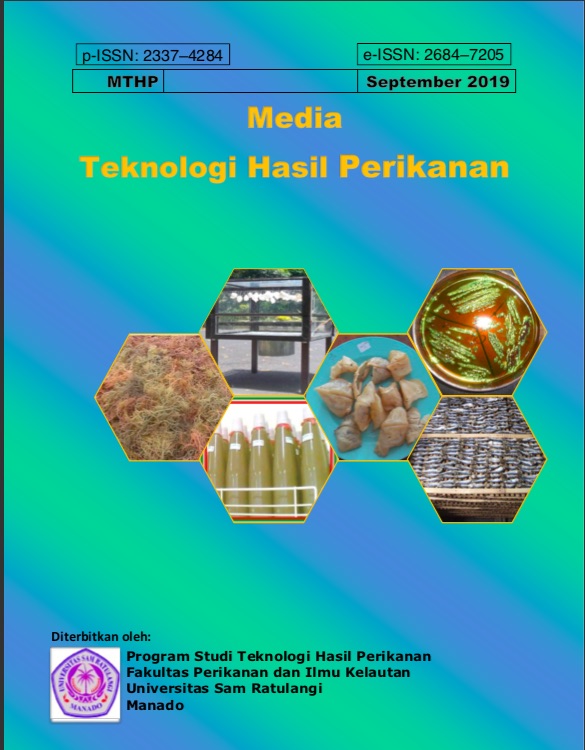KOMPOSISI IODIUM PADA PRODUK MANISAN RUMPUT LAUT
DOI:
https://doi.org/10.35800/mthp.7.3.2019.24367Keywords:
Iodium, Pencucian, Perendaman, Pemasakan, Washing, Soaking, CookingAbstract
Rumput laut jenis Kappaphycus alvarezii digunakan sebagai bahan baku dalam penelitian ini. Rumput laut ini dipotong dengan ukuran 5 dan 15 cm. Tujuan penelitian ini adalah untuk melihat seberapa banyak nutrisi iodium yang hilang selama proses pengolahan manisan pada 2 ukuran potong rumput laut yang berbeda. Penelitian ini menggunakan Rancangan Acak Lengkap (RAL) dengan pola percobaan faktorial 1x2, kombinasi perlakuan diulang sebanyak 2 kali sehingga diperoleh 4 satuan percobaan. Uji ortogonal kontras digunakan untuk melihat apakah ada perbedaan antara dua jenis ukuran potong. Pengamatan dilakukan selama proses pencucian, perendaman dan terhadap produk manisan. Tahapan pengamatan sebagai berikut: pencucian (rumput laut dan air cucian), 3 kali perendaman (rumput laut dan air rendaman) dan dalam bentuk produk manisan. Analisa data menunjukkan bahwa proses pencucian dan perendaman mempengaruhi komposisi iodium pada rumput laut. Kadar iodium K. alvarezii mengalami penurunan selama proses pencucian dan perendaman juga pada pengolahan manisan. Hasil uji ortogonal kontras menunjukkan ukuran potong tidak berpengaruh terhadap kadar iodium manisan rumput laut. Secara umum, proses pengolahan manisan rumput laut tidak menyebabkan kehilangan komponen nutrisi iodium yang berarti.
Â
Kappaphycus alvarezii were used as a raw material of this research. Those were sliced into two different sizes, 5 cm and 15 cm, in order to determine how much nutrition was lost for the two different size and as well as how slice size that affected iodine composition in the final seaweed sweet product. The completely random design with a 1 by 2 factorial experimental pattern, treatment combinations were repeated two times with total of 4 experimental units. To compare the composition of iodine in two size of seaweed used an orthogonal contrast test was performed. The sequence of observation were followed: washing (seaweed and washing water), 3 times of soaking (seaweed and soaking water), and the production of seaweed sweet. Analysis in iodine content in K. alvarezii 1.2% respectively and then showed a decrease after the final soaking process, i.e. 0.45% and 0.7% respectively. This means that more iodine composition was split into the washing water by K. alvarezii 0.7% respectively. The result of analysis variance on iodine content did not find an interaction between two seaweed slice sizes. Orthogonal contrast test showed that there slice size had no effect on sweet iodine content. Seaweed have the necessary characteristics to be used as raw material for processed seaweed products, especially because of their iodine composition. Changes in the composition of iodine during preparation processes do not constitute significant nutrition component losses.
Downloads
Published
How to Cite
Issue
Section
License
Authors who publish with this journal agree to the following terms:
- Authors retain copyright and grant the journal right of first publication with the work simultaneously licensed under a Creative Commons Attribution License that allows others to share the work with an acknowledgement of the work's authorship and initial publication in this journal.
- Authors are able to enter into separate, additional contractual arrangements for the non-exclusive distribution of the journal's published version of the work (e.g., post it to an institutional repository or publish it in a book), with an acknowledgement of its initial publication in this journal.
- Authors are permitted and encouraged to post their work online (e.g., in institutional repositories or on their website) prior to and during the submission process, as it can lead to productive exchanges, as well as earlier and greater citation of published work (See The Effect of Open Access).







